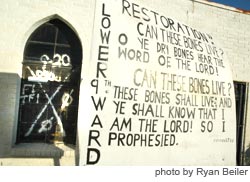 This past week I stood with hundreds of black clergy as the sun rose over a memorial site constructed in the lower 9th Ward to honor the thousands of lives that were lost in the waters of Katrina. The vigil was organized as a part of the third Samuel DeWitt Proctor conference, a conference that draws together nearly 1,000 black clergy, seminarians, and leaders from the across the country in order to strengthen the network among the African American faith community and its leaders, and to increase the community’s capacity to address the needs of those it serves.
This past week I stood with hundreds of black clergy as the sun rose over a memorial site constructed in the lower 9th Ward to honor the thousands of lives that were lost in the waters of Katrina. The vigil was organized as a part of the third Samuel DeWitt Proctor conference, a conference that draws together nearly 1,000 black clergy, seminarians, and leaders from the across the country in order to strengthen the network among the African American faith community and its leaders, and to increase the community’s capacity to address the needs of those it serves.
The rising sun provided a powerful metaphor for the new New Orleans that is struggling to arise from the water-soaked ashes. We stood on sacred ground, in the middle of a neighborhood that has become a symbol of Katrina’s wrath and the persistence and pervasiveness of poverty in America. Pastors from across the still-devastated city spoke passionately about protecting the right to relocate. The very survival of many neighborhoods rests in the rebuilding and revitalization of these anchors of hope and community empowerment. Joe Givens, a lifelong resident of New Orleans and a former community organizer with PICO (People Improving Communities through Organizing), is leading an effort to pair New Orleans churches with churches outside the city for prayer, solidarity, and financial support.
Seventeen months after Katrina hit shore, huge swaths of New Orleans still resemble a ghost land and a disaster area. Empty lots and dilapidated homes appear to be tombstones, marking where lives have been uprooted and shipwrecked by the breaking of the levies. The only visible human activity is the occasional group of volunteers, groups that continue to pour in from across the country to provide the backbone of labor in gutting and repairing houses. In Lakeside, a more affluent and predominantly white neighborhood, the chances of revival are high due to strong and active neighborhood associations and civic organizations. The lower 9th Ward lacks the same degree of civic power. While the machinations of city and state-level politics unfold, neighborhoods are in a race against time to attract enough residents back in order to prove that their neighborhoods can once again be viable. If they cannot prove this, neighborhoods will either die or be resurrected through the hands of developers. The clock is ticking.
On our tour of four neighborhoods I found the biblical references to be profound and haunting. Givens described people displaced as being in a practical exile, waiting and hoping to return to the promised land of their birth. Yet most lower-income families can barely afford the bus ticket back to the city, let alone afford what are now astronomical rents while they go about the task of gutting their homes and starting the arduous process of rebuilding. While the federal government has allocated $4.2 billion to assist these families, only an estimated 400 families have benefited thus far due to red tape and government delay. The “CNN effect” of media attention seems to be passing by the storm of rebuilding that has followed in the aftermath of the storm. Isaiah 58 calls us to be “the repairer of the breach, the restorer of streets to live in.” Will the church take up this spiritual vocation in the face of the gulf coast recovery? We can be repairers by assisting churches that are trying to rebuild one brick and one family at a time. We must also raise a prophetic voice to interrogate failed public policy surrounding the rebuilding effort, ensuring that the former residents’ right to return is protected and that monies actually reach those most in need.

Adam Taylor is Director of Campaigns and Organizing for Sojourners/Call to Renewal.
